Scottish hydrogen: assessment report
Examines how applications of hydrogen-based technologies in transport, industry, heat and whole system approaches can best be deployed in Scotland.
6 Scenarios
6.1 Creating the scenarios
Hydrogen is in the early phase of development as a low carbon energy vector and as set out in Section 5 there are various views as to how hydrogen could or should be produced and used. Setting out different scenarios enables an exploration of the range of possible roles that hydrogen could play in a net-zero economy.
The scenarios have been developed to reflect stakeholder views and be distinct and different enough from each other, to test and explore the boundaries of potential future outcomes. They are not intended to be accurate predictions of the future. The actual outcomes are more likely to be somewhere between these scenarios. An initial round of engagement was conducted where a snapshot of potential hydrogen scenarios were identified, more detail in Appendix A3. Following a further round of engagement, these were narrowed down to 3 scenarios.
3 scenarios were consider Hydrogen Economy, Green Export, and Focused Hydrogen It is assumed that the net-zero target is achieved in all scenarios; it is the extent of hydrogen's role that varies in each. Only hydrogen usage is considered in each scenario, it is assumed that other decarbonisation methods, primarily electrification, are also used to a greater or lesser extent in each.
In each scenario hydrogen makes up different proportions of energy demand in each sector and also has different amounts of hydrogen export. This gives an overall amount of hydrogen in TWh for the three years that have been explored 2025, 2032 and 2045. An assumption has also been made about how hydrogen is produced, with the assumed GW hours of capacity that would be required. Each scenario then has different ways that hydrogen would be transported from sites of production to where it is used, if that is required.
| Context | Each scenario envisages a different approach to hydrogen – whether hydrogen is widely used, used more extensively in certain sector or plays only a niche role. The scenarios examine hydrogen usage in Scotland but the UK and international context is also considered. |
|---|---|
| Demand | Each scenario looks at different ways of using hydrogen in Scotland across 3 main sectors; transport, domestic & commercial heating and, industrial processes & power generation. The scenarios set out whether hydrogen is being used throughout the country, or limited to certain locations and regions. The extent to which Scotland exports hydrogen to the rest of the UK and to Europe is also explored. |
| Production | Considering the demand, each scenario looks at different methods, scales and locations for hydrogen production. Whether it is large scale blue hydrogen produced around natural gas hubs, large scale green hydrogen production from offshore wind or localised green production from onshore renewables. |
6.2 A Hydrogen Economy in 2045
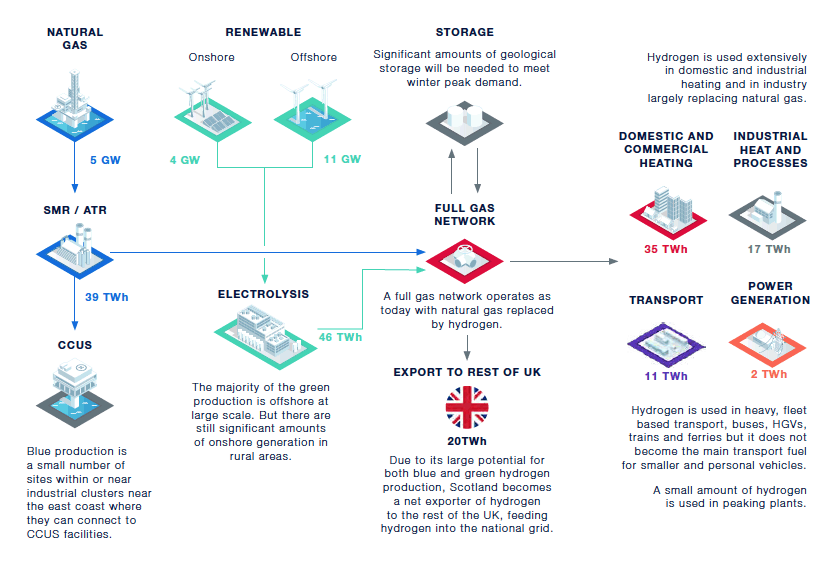
Hydrogen Economy synopsis
Hydrogen is seen as one of the main ways that Scotland can reach its net-zero target. It is therefore used extensively throughout the economy.
A cold morning in January 2045...
Graham from Glasgow wakes up on a chilly winter’s day at 7am, his house is warm from the hydrogen boiler, this is supplied via a connection to the national grid, which turned on automatically at 6am. After taking a shower with water heated from the same boiler, he catches a hydrogen powered bus to his office work in central Glasgow, the office is heated by a large hydrogen boiler also connected to the national grid.
Sandra in Stornoway also wakes up at 7am, her house and hot water have also been heated by her hydrogen boiler which is supplied by her local gas grid, using hydrogen produced from local renewable sources. She drives her EV to work at the distillery, which uses locally sourced hydrogen for all its energy needs.
Key considerations
Conversion of the network
The key driver of this scenario is the conversion of the existing natural gas transmission and distribution network to hydrogen largely decarbonising one of the most challenging sectors - domestic and commercial heating. For this to happen, government and regulatory decisions will need to be taken over the next few years. In the short term it will be critical to focus on building the evidence base on the safety, commercial and consumer acceptability of using hydrogen in the networks and in homes and businesses to support decision making.
Investment requirement
Conversion of large parts of energy infrastructure and building up production capacity will require significant investment. Private investment can be leveraged if a clear revenue stream and business model is in place. Public sector support will likely be required particularly in the early years. This is also will be the case if other decarbonisation methods are used (electrification).
Revenue support requirement in early years of hydrogen usage
In this scenario the bulk of hydrogen is being used in heating and industry where hydrogen is very likely to continue to have a higher unit cost than the current fuel, natural gas in the early years. Over the longer term, carbon taxes could be imposed that will make hydrogen a viable alternative. Before this however, a mechanism that supports the production of and/or use of hydrogen in the network, particularly for heating, will be required. Work is being undertaken by the UK Government on business models for hydrogen production71.
6.3 Green Export by 2045
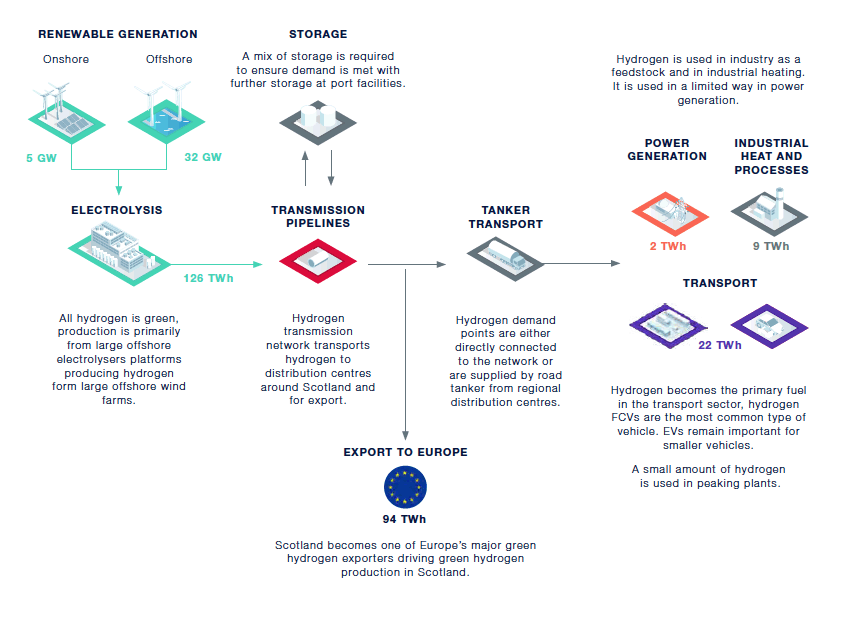
Green Export synopsis
Hydrogen is produced to harness much of Scotland's renewable energy, becoming a major centre of green hydrogen production in Europe. In Scotland, hydrogen is most used in the transport sector, used across all vehicle types.
A cold morning in January 2045...
Graham from Glasgow wakes up on a chilly winter’s morning at 7am, his house has been kept at a constant temperature by an electric air source heat pump, he takes a shower with water heated from a small electric boiler. He catches a hydrogen powered bus to his office work in central Glasgow, the office is connected to a district heating network which has a variety of heat sources.
Sandra in Stornoway also wakes up at 7am, her house and hot water have been heated by a ground source heat pump and an electric boiler. She drives her hydrogen FCV to work, stopping on the way to refuel at the hydrogen refuelling station, which creates its own hydrogen using a local wind farm. She works at the nearby distillery, which uses locally sourced hydrogen for all its energy needs.
Key considerations
The feasibility of large scale green production
Producing the quantities of hydrogen required will be a challenge and will require significant amounts of offshore wind deployment and electrolyser capacity. All indications are that this is feasible but will require further research and clear frameworks to make it happen.
Ability of Scottish hydrogen to compete in the export market
Based on current ambitions, it seems likely that that there will be enough demand for imported hydrogen from countries such as Germany. The challenge for Scotland will be if it can supply this hydrogen at a price that can compete with other potential hydrogen sources, such as green hydrogen from solar in North Africa. More work is required to understand what the price of hydrogen from Scottish offshore wind could be and to build links with potential export markets.
An export market is likely to take time to build as initially countries will produce their own hydrogen, therefore a domestic demand will be needed initially to stimulate growth in production.
Hydrogen as the predominate fuel in transport
An ambitious roll-out of hydrogen in transport is anticipated globally, supplying not only fleet and heavy vehicles, but also personal vehicles. Given the global supply chains Scotland, or even the UK, acting alone is unlikely to stimulate this market. This will only emerge if there are significant commitments from governments globally and large scale investment is made by the major global vehicle manufacturers.
It should be noted that a large scale transport market is not a necessity for an export market to emerge. There could still be enough demand for hydrogen in Europe from other sectors e.g. heavier vehicles and for industrial usage.
6.4 Focused Hydrogen by 2045
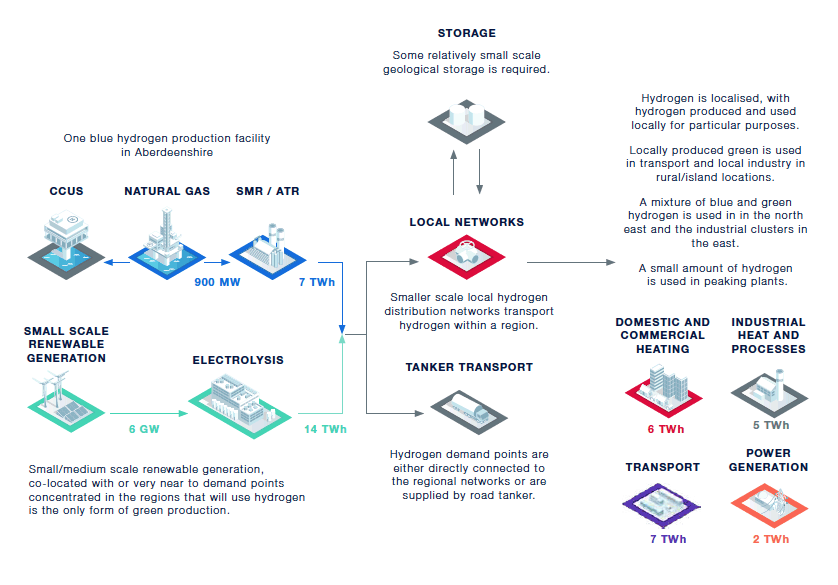
Focused Hydrogen synopsis
Hydrogen plays a supportive role in achieving net-zero, being used to decarbonise sectors and areas where it could have the biggest impact. The production and use of hydrogen is regionalised, with hydrogen largely produced and then used locally.
A cold morning in January 2045…
Graham from Glasgow wakes up on a chilly winter's day at 7am his house has been kept at a constant temperature by the electric air source heat pump, he takes a shower with water heated from his electric boiler. He catches an electric bus to his office work in central Glasgow, the office is heated via a connection to a large district heat network.
Sandra in Stornoway also wakes up at 7am, her house and hot water have been heated by her hydrogen boiler, supplied from the local gas grid. She drives her EV to work at the distillery, which uses locally sourced hydrogen for all its energy needs.
Key considerations
Small scale
This scenario has hydrogen being produced at small scale, even the blue production facility will be relatively modest. This presents challenges compared to the other scenario due to reduced economies of scale, potentially resulting in higher unit costs than could otherwise have been achieved. However, in the sectors and markets where hydrogen is used it is still the most cost efficient solution compared to other decarbonisation alternatives. This is particularly true in rural or island settings where hydrogen also offers a route to exploit local renewable resources that otherwise could not be fully utilised. Support and co-ordination will be needed.
Hydrogen refuelling for HGVs
Hydrogen is widely used in HGVs, even at higher price points, they are still considered to be much more viable than electric HGVs. This does result in a challenge when it comes to creating refuelling networks for the HGVs, which unlike other HGVs such as buses and local fleet vehicles, will need to be able to travel across the country. Outside of areas where there is a hydrogen grid, HGV refuelling stations would need to be supplied by a combination of co-located hydrogen production and grid electricity to ensure the necessary continuity of hydrogen supply.
6.5 The development of hydrogen in each scenario
Each scenario examines hydrogen's role in the Scottish energy economy by 2045, the year that net-zero needs to be achieved in Scotland. These also explore how hydrogen would develop by 2025 to cover short term developments and then up to 2032 to align with the Scottish Energy Strategy and the Climate Change Plan.
Short term - 2025
By 2025 hydrogen will only be a limited part of the energy economy in all scenarios, with each scenario showing a different ambition for the amounts of hydrogen that could be used
Hydrogen Economy is the most ambitious at this stage driven by a blue hydrogen facility, Project Acorn[55], coming online and blending hydrogen into the gas network. The other scenarios only pursue green hydrogen for transport and industrial usage. Focused Hydrogen has the smallest amount of hydrogen overall, with the focus on using onshore renewables for transport or industrial projects in the north east Aberdeen Hub[72], as well as remote and rural areas.
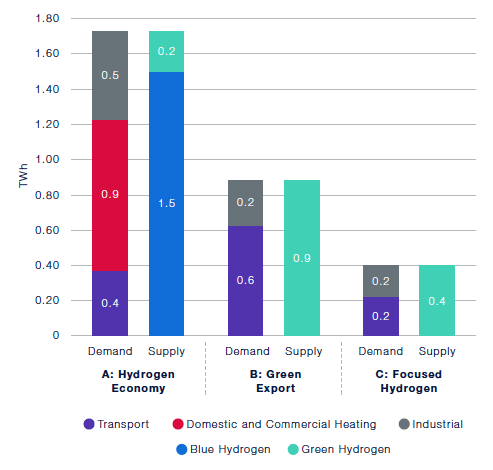
| A. Hydrogen Economy | B. Green Export | C. Focused Hydrogen | |
|---|---|---|---|
| Blue hydrogen production | Acorn facility in north east provides the majority of production supplying 1.5 TWh of hydrogen from a 200 MW plant. | No blue hydrogen in this scenario. | There is no blue hydrogen at this stage in this scenario as the low level of hydrogen demand does not warrant a blue hydrogen production facility. |
| Green hydrogen production | A number of small scale electrolysis production sites spread around the country co-located or very near to demand points totalling around 100 MW, supplying 0.2 TWh of hydrogen. These production sites predominantly use onshore wind including constrained wind. | This is an ambitious scenario with around 400 MW of electrolysers deployed supplying 0.9 TWh of hydrogen in many small/ medium scale onshore production facilities spread throughout the country, co-located or very near to demand points. | Around 150 MW of electrolysers are deployed predominantly supplied with onshore wind co-located or near to demand points. These supply 0.4 TWh of hydrogen and facilities are concentrated in the islands or rural areas. Many will use constrained wind. |
| Transport demand | Some limited small scale conversion of public sector fleets to hydrogen, particularly bus fleets, a small number of HGVs and some pilot use in rail and water transport projects. Total transport demand is 0.4 TWh. | A more ambitious programme of hydrogen conversion of public sector fleets and other fleet vehicles, such as local delivery vehicles and HGVs. A small number of public hydrogen refuelling stations serving a very small number of personal hydrogen FCVs at this stage. Total transport demand is 0.6 TWh. | Limited small scale Conversion of public sector fleets, though concentrated in certain areas including the north east as well as island or remote areas. A total of around 0.2 TWh is used in transport. |
| Domestic & commercial heating demand | Hydrogen is blended into the gas grid, up to 2% at this stage. This makes up nearly all the demand from the blue hydrogen facility. Some pilot 100% hydrogen projects have been set up serving a very limited number of homes, such as H100 and the local network in Stornoway. Total building demand is 0.9 TWh. |
Hydrogen is not used in domestic or commercial heating in this scenario. There is no blending into the gas network. | There is no use of hydrogen in the network yet in this scenario. |
| Industrial demand | Gas network connected to industrial customers who use blended hydrogen. Some experimentation with higher hydrogen blends are used in some industrial processes. Total industrial demand is 0.5 TWh. |
Hydrogen directly supplies some industrial processes, including users not already connected to the gas grid in more rural areas. All hydrogen production is co-located or very nearby demand so relatively limited. A total of around 0.2 TWh is used in Industry. | Limited usage of hydrogen in industrial processes, using locally produced hydrogen. A total of around 0.2 TWh is used in Industry. |
Medium term - 2032
The deployment potential in the medium term represents how the sector will evolve over the next twelve years. The larger projects that will be deployed by 2032 will need to start development in the next few years.
By 2032 hydrogen usage has grown in all scenarios, but with different balances of supply and demand. In Hydrogen Economy more hydrogen is being used in the gas network and most of this is blue hydrogen. However, more green has now come into production including some large scale production using offshore wind. In Green Export there is significant volume of green hydrogen production and the export market is already taking up a significant proportion of demand. In Focused Hydrogen there is now a small blue facility which is feeding a network in the north east and there is an expansion in green usage in rural or island locations across all sectors.
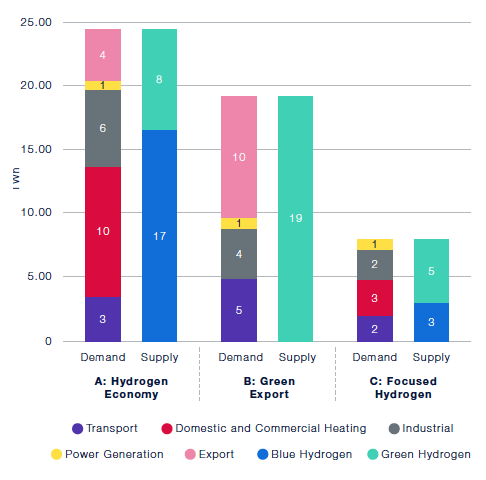
| A. Hydrogen Economy | B. Green Export | C. Focused Hydrogen | |
|---|---|---|---|
| Blue hydrogen production | The Acorn facility in the north east has expanded and an additional facility producing blue hydrogen is operating around the Grangemouth industrial cluster. Total of 2 GW of capacity supplying 17 TWh of hydrogen. | No blue hydrogen in this scenario. | A small scale blue hydrogen production facility has come online to supply the local network in the north east. Total of 400 MW capacity supplying 3 TWh of hydrogen. |
| Green hydrogen production | Expansion in size and number of electrolysers, 2 GW of onshore renewable energy capacity is used to make hydrogen. Large scale production offshore has started to come online reaching around 1 GW of capacity. This hydrogen is connected to the transmission network and/or directly to large demand centres. In total there is around 8 TWh of green hydrogen produced. |
Expansion in size and number of electrolysis sites around 4 GW of onshore wind capacity is used to produce hydrogen. Large scale offshore hydrogen production from dedicated wind has started to come online reaching 3 GW of capacity and accounting for around half of all production. Around 19 TWh of green hydrogen is supplied in total. |
Expansion in size and scale of onshore renewables, 2 GW of capacity is used to supply around 5 TWh of green hydrogen. There is no large scale offshore in this scenario. |
| Transport demand | Further increase in use across fleet transport with more hydrogen buses and other public sector fleet vehicles. Hydrogen also increasingly used in commercial fleets. A total transport demand is around 3 TWh. | Significant increase in hydrogen use in fleet vehicles. Also, significant uptake in personal hydrogen FCVs, driven by ban on petrol and diesel vehicles in 2032. A total transport demand is around 5 TWh. | Increase in fleet vehicle usage in areas where hydrogen is being produced – east coast as well as Island and rural locations. A total transport demand is around 2 TWh. |
| Domestic & commercial heating demand | Increase in blending of hydrogen into the gas network, with up to 20%. Some areas of the distribution network have been converted to 100% hydrogen, led by areas close to hydrogen production such as the east coast and independent networks. Domestic and Commercial demand totals around 10 TWh. |
Hydrogen is not used in domestic or commercial heating in this scenario. Many buildings are converted to electrification, though the gas network is still running at this stage. | Increase in blending into the distribution network and some limited conversion of the regional network in the north east and the small local 'off grid' networks in island or rural areas. For example, the self-contained gas network in Stornoway. Domestic and Commercial demand totals around 3 TWh. |
| Industrial demand | Increased blend of hydrogen in existing industrial gas use, conversion of some industrial processes to 100% hydrogen. Some use de-blend hydrogen from the network and some direct connection of large industrial usage to a hydrogen source. A total of around 6TWh is used in industry and a further 1TWh in power generation. | Some conversion of large scale industrial processes using green hydrogen directly connected to a new hydrogen network. Limited number of small scale industry, in island or rural areas using co-located onshore production. A total of around 4 TWh is used in industry with a further 1 TWh used in power generation. |
Increased blend of hydrogen in existing industrial gas use and some limited conversion of small scale industrial processes to hydrogen, particularly in north east and island or rural areas. A total of 2 TWh is used in industry with a further 1 TWh in power generation. |
| Hydrogen export | Scotland produces more than it needs and so becomes a net exporter of Hydrogen to the rest of the UK. Around 4 TWh is produced in Scotland and used elsewhere in the UK. | High volumes of hydrogen starting to be exported to the rest of the UK and wider Europe. A total of around 10 TWh of hydrogen is exported outside of Scotland. | No export of hydrogen. |
Net-zero - 2045
By 2045 Hydrogen Economy has the largest amount of hydrogen being used in Scotland with 65 TWh. However, it is now Green Export which has the largest amount of hydrogen production driven by a large expansion in the use of offshore wind to create green hydrogen in large quantities with transport the biggest user of hydrogen domestically. Focused hydrogen has significantly lower usage than the other two, concentrated in a few regions where it is used in a number of applications and in the heaviest, long duty vehicles.
Note that in all scenarios, even Hydrogen Economy, a significant amount of energy will be needed from other low carbon sources, principally electricity. The amount of electricity that would be required has not formed part of the analysis.
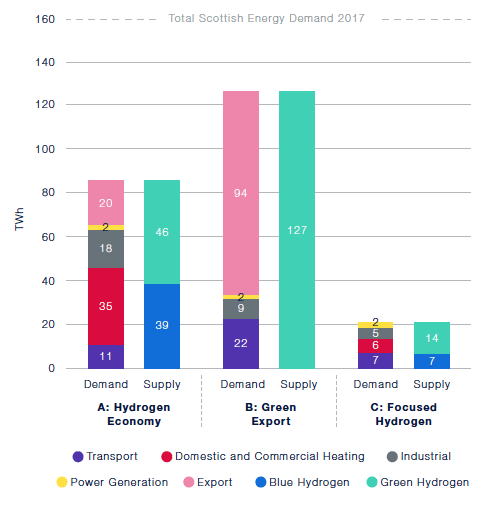
Contact
Email: onshoreoilandgas@gov.scot
There is a problem
Thanks for your feedback